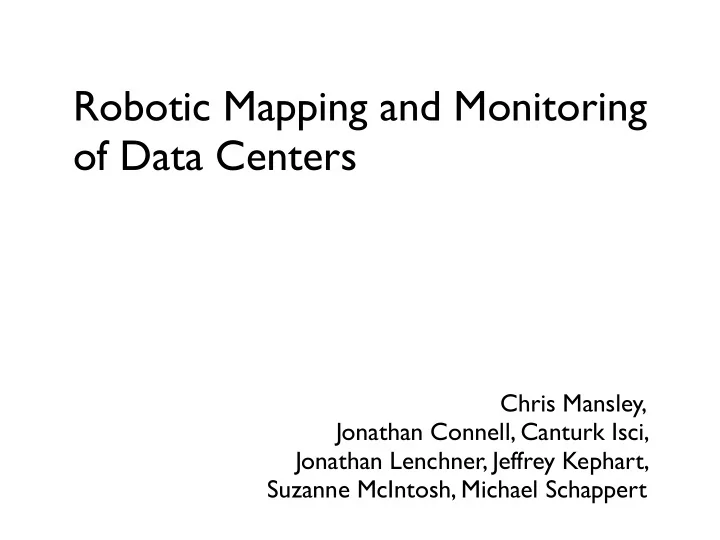

Robotic Mapping and Monitoring of Data Centers Chris Mansley, Jonathan Connell, Canturk Isci, Jonathan Lenchner, Jeffrey Kephart, Suzanne McIntosh, Michael Schappert
Data Center Motivation • Data centers (DCs) worldwide emit the equivalent of 50% of all airplane carbon dioxide emissions • Roughly equivalent to the total output of Malaysia, little more than the Netherlands • HVAC systems utilize 30-50% of the total data center energy consumption
Monitoring • Static sensors provide spatially sparse, temporally dense thermal measurement • Retrofitting older data centers can be cost prohibitive • Existing sensors can be manually integrated into current asset management and analytics packages
First Attempt
Proof-of-Concept • Autonomous robotic platform • Low cost • Robust • Layout Generation
Proof-of-Concept Camera Thermocouple Interface 2m Sensor Pole 1.6GHz Atom iRobot Create
Video
Can we selectively sample a subset of data center locations, while accurately capturing the overall thermal profile? Yes! Our solution uses Gaussian Process Regression [Singh et al. , Guestrin et al.] to 1. Interpolate acquired samples 2. Estimate interpolation uncertainty 3. Select sub-sampling locations using mutual information or entropy
Thermal Mapping
Thermal Mapping
Thermal Mapping
Selective Sampling
Summary • Static sensors provide dense temporal resolution, but sparse spatial resolution • Autonomous monitoring platforms provide an adaptive tradeoff between spatial and temporal density at a lower cost • Data center monitoring and analytics provide a promising domain for robotics research and automation
Thank You • Canturk Isci, Jon Lenchner • Jon Connell • IBM Research
References • C. Guestrin, A. Krause, and A. P . Singh, “Near-optimal sensor placements in gaussian processes,” in Proceedings of the 22nd International Conference on Machine Learning, 2005 • A. Singh, A. Krause, C. Guestrin, W. Kaiser and M. Batalin, “Efficient planning of informative paths for multiple robots,” in Proceedings of the 20th International Joint Conference on Artifical Intelligence, 2007.
Recommend
More recommend